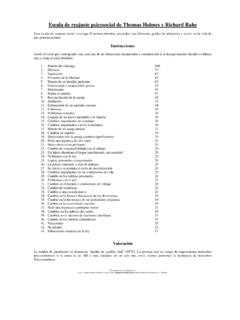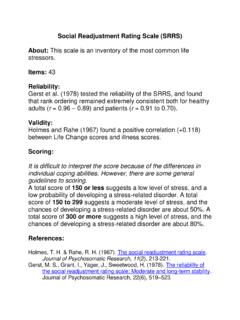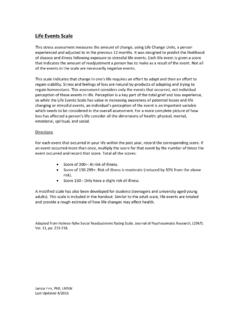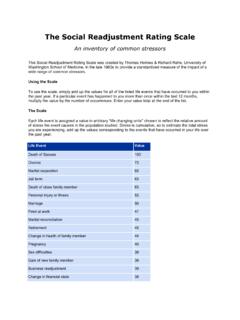Transcription of THE STANDARD STRESS SCALE (SSS): MEASURING STRESS IN …
1 Christiane Gross and Katharina Seeba THE STANDARD STRESS SCALE (SSS): MEASURING STRESS IN THE LIFE COURSENEPS Working Paper No. 45 Bamberg, June 2014 NEPS WORKING PAPERS Working Papers of the German National Educational Panel Study (NEPS) at the Leibniz Institute for Educational Trajectories (LIfBi) at the University of Bamberg The NEPS Working Papers publish articles, expertises, and findings related to the German National Educational Panel Study (NEPS). The NEPS Working Papers are edited by a board of researchers representing the wide range of disciplines covered by NEPS. The series started in 2011. Papers appear in this series as work in progress and may also appear elsewhere.
2 They often represent preliminary studies and are circulated to encourage discussion. Citation of such a paper should account for its provisional character. Any opinions expressed in this series are those of the author(s) and not those of the NEPS Consortium. The NEPS Working Papers are available at bersicht/publikationen/nepsworkingpapers Editorial Board: Jutta Allmendinger, WZB Berlin Cordula Artelt, University of Bamberg J rgen Baumert, MPIB Berlin Hans-Peter Blossfeld, EUI Florence Wilfried Bos, University of Dortmund Edith Braun, DZHW Hannover Claus H. Carstensen, University of Bamberg Henriette Engelhardt-W lfler, University of Bamberg Frank Kalter, University of Mannheim Corinna Kleinert, IAB N rnberg Eckhard Klieme, DIPF Frankfurt Cornelia Kristen, University of Bamberg Wolfgang Ludwig-Mayerhofer, University of Siegen Thomas Martens, DIPF Frankfurt Manfred Prenzel, TU Munich Susanne R ssler, University of Bamberg Marc Rittberger, DIPF Frankfurt Hans-G nther Ro bach, LIfBi Hildegard Schaeper, DZHW Hannover Thorsten Schneider, University of Leipzig Heike Solga, WZB Berlin Petra Stanat, IQB Berlin Volker Stock , University of Kassel Olaf Struck.
3 University of Bamberg Ulrich Trautwein, University of T bingen Jutta von Maurice, LIfBi Sabine Weinert, University of Bamberg Contact: German National Educational Panel Study (NEPS) Leibniz Institute for Educational Trajectories Wilhelmsplatz 3 96047 Bamberg Germany The STANDARD STRESS SCALE (SSS): MEASURING STRESS in the Life Course Christiane Gross, University of Konstanz Katharina Seeba , Friedrich-Alexander-Universit t Erlangen-N rnberg E- mail address of lead author: Bibliographic data: Gross, C. & Seeba , K., ( 2014). The STANDARD STRESS SCALE (SSS): MEASURING STRESS in the Life Course (NEPS Working Paper No.)
4 45). Bamberg: Leibniz Institute for Educational Trajectories, National Educational Panel Study. NEPS Working Paper No. 45, 2014 Gross, Seeba The STANDARD STRESS SCALE (SSS): MEASURING STRESS in the Life Course Abstract This contribution presents the STANDARD STRESS SCALE (SSS); this is a new SCALE which has been specially developed to meet the requirements of multicohort panel studies, such as the National Educational Panel Study (NEPS), which refer to the whole life course. Accordingly, the SSS is consistently applicable for different age groups from 14 years old onwards and is also suitable for a wide range of people irrespective of their stage in life and employment situation; the items are applicable for old-age pensioners, unemployed, employed and self-employed, househusbands and wives, for university students and so forth.
5 To obtain the final 11-item STANDARD STRESS SCALE (SSS), 35 questions regarding stressful life situations, social STRESS , daily distress, anxieties about the future and other stresses and strains were developed following the theoretical approach of the effort-reward imbalance model (ERI) and the demand-control model. These 35 items were pretested with different subsamples such as students in different school types, university students, and adults in different life stages using self-administered questionnaires. The total sample of the pretest includes 372 respondents. All of the 35 original questions had a small item-nonresponse rate and a good variance among respondents.
6 Using factor analyses, the questions with the highest factor loading on each of the dimensions were used to represent the final 11-item SSS. In some cases, when the questions with the highest loading did not perform well in the cognitive pretest, the item with the second highest loading was chosen instead. Although the most distinct items were selected, the final 11 items of the SSS show good reliability values. For all subsamples, the Cronbach's Alpha values vary in a range from for the unemployed to for students. In addition to this, further analyses show a high correlation of the final SSS with self-rated health.
7 Keywords STRESS , distress, SCALE , index NEPS Working Paper No. 45, 2014 Page 2 Gross, Seeba 1. Introduction STRESS is one of the main determinants of health status (Back , Seidler, Latza, Rossnagel, & Schumann, 2012; Steptoe, 1991); therefore an instrument to adequately measure STRESS is of prime interest not only in public health research but also for the examination of educational returns. School and workplace requirements are both essential sources of STRESS , and STRESS levels can also be affected by unemployment. To provide excellent data on nonmonetary returns to education such as health is one focus of Pillar 5 (Returns to Education Over the Life Course) of the National Educational Panel Study (NEPS).
8 NEPS aims to use a constant SCALE , which meets the standards of survey methodology, to measure STRESS for different age groups and living conditions. As none of the existing scales meets these requirements, we have developed the STANDARD STRESS SCALE (SSS) which is applied by NEPS but can also be used in further surveys. The SSS is applicable for different age groups (14 years and above) and is also suitable for all sorts of people irrespective of their stage in life and employment situation. The SSS will be applied in the NEPS Starting Cohort 3 Grade 5 (in Grade 8), Starting Cohort 4 Grade 9, Starting Cohort 5 First-Year Students, and Starting Cohort 6 Adults.
9 We first present previous STRESS scales to underline the need for development of a new instrument to measure STRESS in the life course (Section 2). Then we outline the theoretical dimensions of STRESS on which the STANDARD STRESS SCALE is based (Section 3), introduce the methods used to develop the SCALE (Section 4) and also the results of the cognitive pretest and factor analyses along with an explanation of how to build a STRESS index (Section 5). Finally we show some attributes of the resulting STRESS index based on the SSS (Section 6). 2. Previous STRESS Scales A variety of previous instruments to measure STRESS , available in a German version, are summarized in Table 1.
10 (a) Possibly the most popular instrument is the Effort-Reward Imbalance SCALE (ERI) (Siegrist, 1996; Siegrist, Starke, Chandola, Godin, Marmot, Niedhammer, & Peter, 2004), which is based on the theoretical concept of reciprocity. The model of effort-reward assumes that negative emotions occur when the effort made by a person is much higher than the reward the person receives, meaning that the main principle of reciprocity has been violated. Although the original SCALE was established to measure STRESS in the workplace only, Siegrist and colleagues developed further scales addressed to school (Li, Shang, Wang, & Siegrist, 2010) and university students (in preparation).




